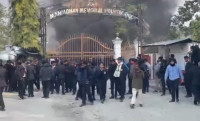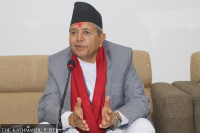National
Pandemic delays dozens of projects, from mega to small, that were on their final lap
Apart from time and cost overruns for the private and government-funded projects, the impact will also be on the country’s economy which could incur heavy potential output losses worth billions of rupees.
Sangam Prasain & Prithvi Man Shrestha
The Gautam Buddha International Airport in Bhairahawa was expected to be up and running at the end of this year. Similarly, the 456MW Upper Tamakoshi in Dolakha, was to begin production by October this year.
Both the projects were on their final lap when the Covid-19 pandemic struck. There is now uncertainty over their completion.
The two projects needed technical manpower and experts from abroad. The Covid-19-induced lockdown and ban on international flights meant no one could enter the country.
Along with these two, several other large projects have also been delayed.
In the case of Nepal’s second international airport, foreign technical manpower was set to arrive to install the runway lighting system and other equipment.
The country’s largest hydropower plant is also awaiting foreign technical manpower for the commissioning and testing, the final phase before production begins.
Officials at these projects said they are unable to definitely tell when they will come into operation.
“We are not sure on the operation deadline of the airports now,” said Pradip Adhikari, chief of the national pride projects under the Civil Aviation Authority of Nepal.
The government has not said when it will allow skilled manpower needed for such projects to fly in, although it has announced that foreigners working for diplomatic missions will be allowed to enter from September 1.
After the lockdown was lifted in the third week of July, projects both big and small, funded either by the government or private institutions, were allowed to mobilise workers only for civilian work.
“Obviously, there is a challenge to bring skilled manpower to install the equipment, although most of the equipment have arrived,” said Adhikari. “We will request the government to allow projects to bring the technicians even if it means chartering flights.”
The Gautam Buddha airport project needs to bring technicians from Austria, the United States and Vietnam, according to Adhikari, who also oversees another international airport being built in Pokhara .
The Pokhara International Airport was scheduled to be completed six months before its stipulated deadline of July 10 next year because of the good progress it was making before Covid-19. But officials, now, say that too may not happen.
All equipment for the second package—installation of communication, navigation and surveillance, air traffic management and meteorological equipment—of Gautam Budha airport is here, but the Thai contractors have not been able to come or send their technicians.
Similarly, the progress of Upper Tamakoshi Hydropower Project has been idled with almost 99 percent of its work complete.
Bigyan Shrestha, chief of the Upper Tamakoshi project, said even during the pandemic, works in the project continued, albeit at a slower pace.
“The project is now at the testing and commissioning phase–one of the most sensitive and final stages in a hydropower project,” said Shrestha. “But we have been unable to bring skilled manpower from India, China and some European countries, as there were no flights.”
The project which was supposed to produce 76 MW in the first phase is unlikely to meet the deadline, according to Shrestha.
“A pandemic situation will push the deadline by at least one month,” Shrestha told the Post.
His assumption is based on the scenario that the government will allow them to bring in the required skilled manpower by September.
Projects being developed by the private sector have also been badly affected and many of them are in limbo, as they too are unable to bring the technical manpower from abroad.
“Over 90 percent projects of the private sector have been at a standstill for the last six months,” said Shailendra Guragain, immediate past president of Independent Power Producers Association of Nepal. “Neither construction work of new projects could start nor maintenance work on ongoing ones could be done, as the necessary spare parts and manpower are not available.”
Guragain said had there not been the pandemic, around 1,500MW of electricity from the private sector would have been connected to the national grid by now.
This output from the private sector alone would have been more than the total 1,200MW, the highest ever being generated in the country’s history since the 500KW Pharping Hydroelectric Plant began production in 1911.
“The pandemic has forced the private sector to incur heavy losses and the country’s economy is also suffering output losses amounting to billions of rupees,” said Guragain.
Projects like the 140MW Tanahu Hydropower Project on the Seti River, the 111MW Rasuwagadhi Hydroelectric, the 120MW Rasuwa-Bhotekoshi Hydropower, the 102MW Madhya Bhotekoshi Hydropower, and the 37MW Upper Trishuli 3B Hydropower are all languishing.
The Upper Trishuli 3B, a joint venture project between the Nepal Electricity Authority and Nepal Telecom, also looks set for missing its projected completion deadline of mid-March 2021.
According to the project officials, before the pandemic hit, the progress was largely on track.
“But now it will be pushed further by at least one year,” said Mohan Gautam, managing director of Upper Trishuli 3B. “We could not work in the dry season and there is uncertainty over when the situation will normalise so that we can get back to work.”
Work was almost completely stalled as most of Chinese technical staff who had gone home for the Chinese New Year in January did not return due to international travel restrictions following the pandemic.
“Of the 60 technical employees who had gone home, eight to ten returned in February, but there is little progress,” said Gautam.
Construction equipment of the Upper Trishuli 3B project has been stranded at the bordering Chinese town Kerung since January. Even after the reopening of the border, Chinese authorities have not cleared the equipment to pass through.
The story of the Dhalkebar substation of the Dhalkebar-Muzaffarpur cross-border transmission line project, which is being constructed to export power from Nepal, is similar.
The 400KV substation is a key substation to distribute electricity to east and west from the 456MW Upper Tamakoshi. It will also be a major point to export surplus energy to India. The operational Dhalkebar-Muzaffarpur 220kV is being upgraded to a capacity of 400kV for this purpose.
The substation was supposed to start charging electricity in the transmission line by May-end. But equipment for substation was stranded at Kolkata port in India and was brought to Nepal only in June-end.
“Bringing Indian technical workers to conduct initial testing of the substation also took time,” said Shukra Devkota, chief of the project.
Then Indian and Nepali workers returned home after the lockdown which was lifted on July 21.
“Before the lockdown, there were nearly 400 workers, now only 80 to 90 are working,” said Devkota.
The testing kits for the project are also stranded in Kerung for the last one month.
Citing the threat of Covid-19, the Chinese authorities have been clearing limited trucks of goods every day on priority basis, particularly medical and other consumer goods.
After extensive lobbying, permission was granted to clear the supply of equipment by early August. But that could not happen due to landslides on the bordering Chinese side.
“Once the machine arrives, the transmission line can be charged with electricity in 10 to 15 days,” said Devkota.
The project is also seeking the government’s approval to bring Indian technical staff to observe the final testing as it is the cross-border transmission line.
Another project affected by the pandemic is the Rani Jamara Kulariya Irrigation Project, also a national pride project, in Kailali district. Works on intake and feeder canals have already been completed. But works of the main canal and its extension and 4.71MW hydropower project, a component of this multipurpose project, have been badly affected.
Prem Lasiwa, information officer at the Rani Jamara Kulariya Irrigation Project, said the works on the 8.86-km main canal should have been completed by mid-April .
“But it could not happen as the workers could not be brought to the project site due to lockdown,” said Lasiwa. “Once the situation normalises, the work in the main canal will be completed within a month.”
Progress on the 14.65km extended main canal has been slow with 75 percent completed.
“This section was supposed to have been completed by mid-June but we need to extend the deadline,” said Lasiwa. “There were around 180 workers deployed before the lockdown. Now, there are around 60.”
Once completed, it will irrigate 14,300 hectares of land.
There has been 70 percent progress in the hydropower component. The reasons are similar—lack of materials and manpower.
The construction sector contributes over seven percent to the national economy and contributes to the service sector as well.
“The pandemic’s impact on the construction sector is going to have a severe effect on the economy,” said Shankar Sharma, former vice chairperson of the National Planning Commission. “Given the circumstances, there will either be meagre growth or contraction in the economy in the current fiscal year.”




 10.12°C Kathmandu
10.12°C Kathmandu
















